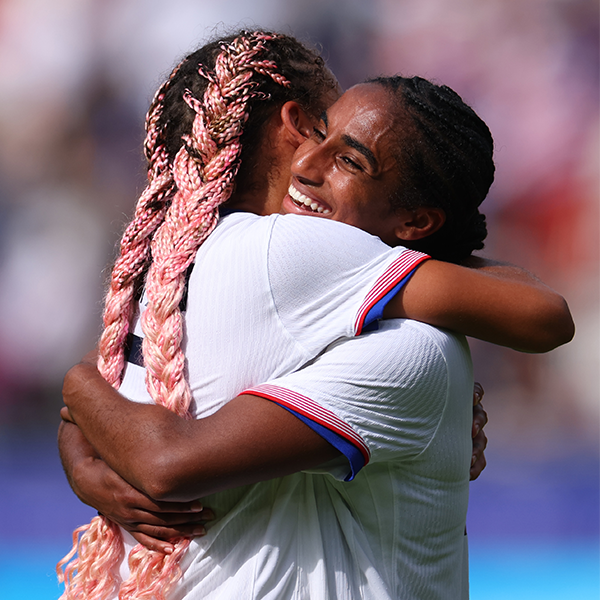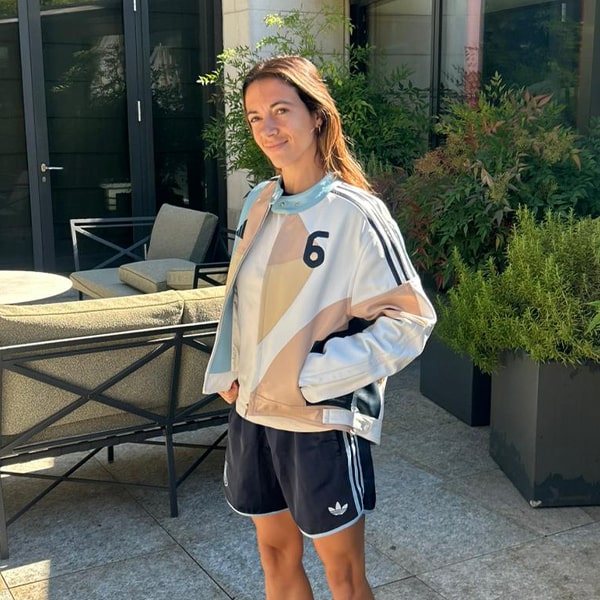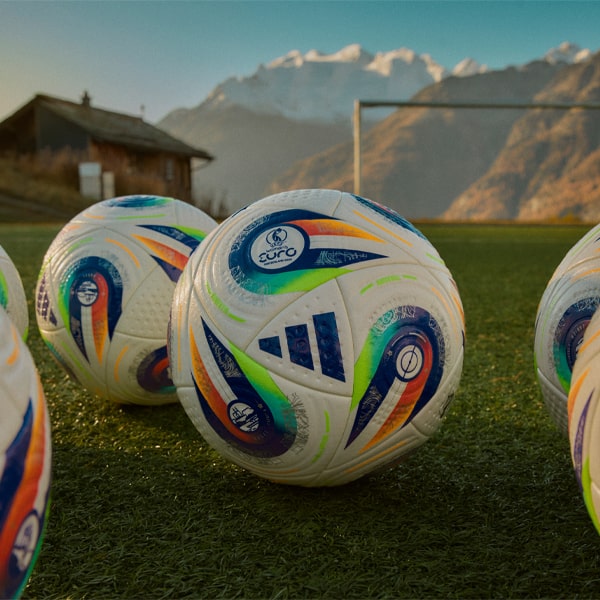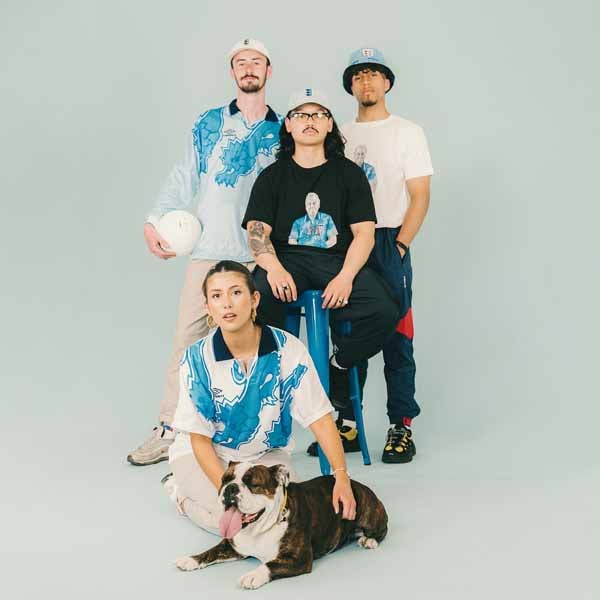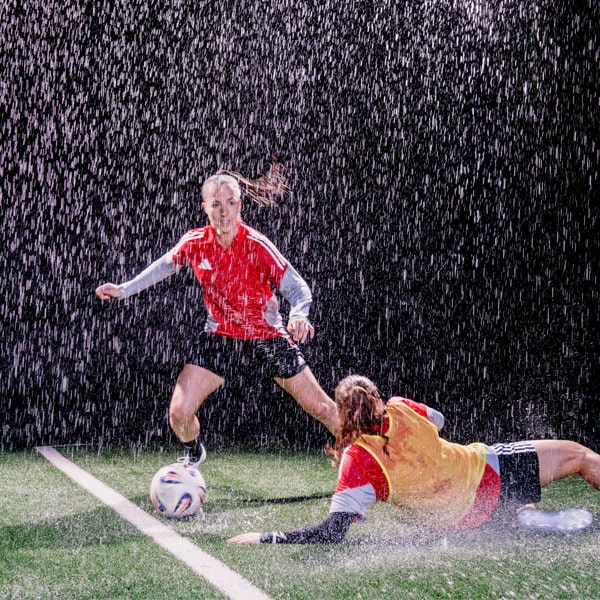As the countdown to the Women’s EUROs ticks on, there's a focus on more than just the football. Tipped to be the biggest tournament yet, this summer’s showdown is shaping up to be a full-on flex for nail game as much as goal game. Under the header Creative Soccer Culture, SoccerBible set out to investigate the booming culture of nail art in women’s football.
You’ve probably already clocked it: the flash of gloss disrupting team kit uniformity. Nail art is no longer a subtle sideline — it’s part of the player kit.
Take Denmark and Real Madrid striker Signe Bruun — whimsical short red gels bringing cognitive dissonance to those in the way of her goal massacres. Or Alisha Lehmann, Switzerland and Juventus’ poster girl for beauty-meets-ball, whose constant nail switch-ups – long, short, neon, nude, she’s done it all – mirrors her playful style of play.Then there’s England and Arsenal’s Alessia Russo, whose chrome gels have become so iconic they earned their own shade, courtesy of an Aussie nail tech during the 2023 World Cup.
And the EUROs build-up? Already a keratin canvas the size of Switzerland. Michelle Agyemang, Jess Carter and Ella Toone all flashed different shades of polish for the Lionesses’ M&S x England campaign. Meanwhile, Netherlands' Dominique Janssen turned up to camp with a fresh set dipped in — what else — patriotic oranje.
This isn’t just at trend. It’s a statement. It’s the beautiful game with an extra coat of polish.
While manicured nails in women’s football are nothing new, this overflowing of painted nails and nail art comes at a time when women’s football is experiencing unprecedented growth globally, this EUROs being the most recent and glaring testament to that: The prize pool is at €41m, a 165% increase since the 2022 EUROs; 600,000 fans have already secured their tickets for the 31 matches, which is more tickets sold than at the end of the 2022 tournament. And, finally, the tournament is expected to generate over €32m in sponsorship revenue, a whopping 112% increase from 2022.
All these numbers of course tell a broader story about how women players are gaining visibility. This has so far manifested itself in not only partnerships with bigger brands, but partnerships with a certain type of brands, unthinkable in the realm of football just a few years ago: Beauty brands. From PSG Féminines’ recent deal with Ilia Beauty to Arsenal Women’s partnership with Il Makiage, these deals serve as a symbol of how women’s football quite literally is changing the face of football. Brawn and beauty are no longer each other’s opposites. Why not score a header with a perfectly moisturised forehead? Why not wear red lipstick to go with a potential bloody nose? Whether the intention or not, the brow pencil and makeup brush feel like tools for women footballers to carve out ‘a room of one’s own’ — in a footballing space that, for so long, has been reserved for, defined and monopolised by men.
In a global sports climate where athletes are now cultural icons, especially by way of social media providing the freedom to showcase their personality and personal style off the pitch, you can't help but wonder why nails in football have so far received limited attention from brands and press alike. Aren't they bearers of the same symbolism of agency and even activism associated with makeup in women's football? (Yes. The now popularised nail art and long acrylics is significantly influenced by black communities, and Florence Griffith-Joyner’s trailblazing long acrylics at the 1984 and 1988 Olympics were considered ‘low-class’ by critics).
While this negligence might be considered a testament to the very nature of nail art – on one hand easy to overlook and dismiss as ‘unimportant’ or 'silly', on the other hand a signifier of rebellion and personal expression in a regimented environment — it also begs the question: is getting your nails done still considered a ‘silly pastime’ for women, just the way some view women’s football?
Under the header Creative Soccer Culture, SoccerBible set out to investigate the booming culture of nail art in women’s football. We asked two 2025 EUROs players what getting their nails done means to them, a nail artist how the growth in women’s sports manifests in the nail salon, and an expert in the business of sports why nail brands haven’t jumped on the women’s football band wagon yet.
“For me, it’s like I’m doing something for myself, it’s a type of self-care. It just feels good to go on that pitch with fresh nails. We are all wearing the same kit, and this is a way of choosing something for myself”, says Signe Bruun about why she almost always plays with (red) painted nails. We meet her at the training camp for the Danish national team. Denmark is a staple at the EUROs, participating for the 11th time with their personal best being silver in 2017. This year, they have their work cut out for them in group C, where they’ll be going up against titans Germany and Sweden and possible surprise Poland. Bruun, who luckily can’t help but score — this season, she tied for fifth with Ballon D’or winner Aitana Bonmati on the Liga F top scorer rankings, and she has netted for Denmark 24 times in 52 matches — shows up for the interview with a fresh set of bright coral gels.
”I started getting my nails done a few years back. I was going through a difficult period mentally and getting them done was a way for me to shake things up, do something different. I know it’s not a big thing, but it just looks good and feels nice, so I kept it up after that”, she says, adding that getting her nails done has less to do with the so-called ‘lipstick effect’, which refers to how makeup and other affordable selfcare products can boost confidence and performance, than with getting a break from her footballing duties: “About once a month, Caroline Møller (now former teammate) and I will go on a ‘nail date’ in Madrid. We’ll have a coffee at the coffee shop next to the nail salon and then get our nails done. It’s like our nice afternoon in Madrid”.
Cornelia Kramer, Denmark and Bayer Leverkusen striker who, at the age of 22, will appear in her first EUROs, shows up for the interview with a set of French acrylics “that needs to be redone”. She is having quite the year, having just been named Bayer Leverkusen player of the season and finishing sixth in the league top scorer rankings. “Manicured nails is a bit like getting ready in the morning. I feel more refreshed and presentable, and I feel like I exude that I am ready for the day. You know, ‘Look good, feel good, play good’.”
Equally to Bruun, going to a nail salon serves as an off-pitch bonding ritual with Kramer's teammates: “Getting my nails done really started when I came to Germany (in 2024). It’s one of those things you can do together off the pitch as a team. You go get a coffee and get your nails done. And it’s one of those things where you can add something yourself. And it will last, whereas makeup can be difficult to maintain during a match. Nail polish will always stick”.
Does she feel like there’s been a change in how women footballers present themselves on the pitch? “I think so, and I also think that people notice us more. Without offending anyone, women’s football was a bit more masculine before, and I think nails is a way of changing that. I will say, though, that even though nails, for me, are connected to femininity and ‘vanity’, it's not like male players aren't vain too; like, they will style their hair to perfection. I feel like getting your nails done is the female equivalent to that. You don’t feel the most feminine when you play football. At the end of the day, it's just a way of expressing yourself. Some players will play with long nails just to provoke.”
Rash minds might write off nail art as a dainty pastime for women, but archaeologists have found a solid gold manicure set, dating to 3,200 BC, in Southern Babylonia that was seemingly part of men’s battle uniforms. Since sports is a (non-lethal) battle, the marriage between nails and sports makes perfect sense. And nail art does have a long and rich history in the space of sports, not least carried forward by BIPOC track and field stars, especially during the Olympics — from Florence Griffith-Joyner in the 80s to, of course, Sha’Carri Richardson at the 2024 Olympics.
In general, the 2024 Paris Olympics served as not only a mirror of the popularisation of nails in broader culture, but became a watershed moment for nail art in sports. It was everywhere. And not only in the sports arenas. Simone Biles took her TikTok followers to the nail salon to get her 3d tips done; team GB habitually posted Olympics and Union Jack themed nails on their Instagram, and there even was a buzzing nail salon in the Olympic village.
Tammy Koslowski, nail artist and owner of the nail salon House of NAF! in Glasgow, was ahead of the curve when she and her salon created nail art inspired by the kits of the Women’s World Cup for a piece for Hypebae back in 2019. The rise in the convergence of nail art and sports is undeniable, according to her, and shows in a changing clientele: “We’ve definitely seen more athletes coming in. Not always for nail art, sometimes just for regular maintenance. But for bigger events like tournaments or competitions, they’ll often get themed nail art.”
It also shows in the type of designs clients are requesting:
“Sports-themed nails have definitely become more popular and more celebrated, especially as women in sport get more recognition and visibility. With traditional gender norms being challenged more openly, self-expression through things like nail art is now more inclusive and embraced. Athletes are being celebrated for showing personality through things like team-colour nail art, and that also gives the media something to write about that grabs attention, i.e 'Simone Biles Debuts Olympic Rings Nail Art at Tokyo 2020'", Koslowski says, adding: “It's a shame the focus isn't always on their athletic performance, but it does show how much interest there is in how athletes express themselves.””
For her, athletes paying more attention to their appearance, including their nails, is a result of the increased exposure of women athletes:
“Athletes are in the public eye and videoed and photographed a lot, and just like anyone else in those circles they will get regular maintenance appointments like brows, facials, massages and nails fall into that too. A lot of athletes need to keep their nails short for practical reasons, but we use protective products that prevent chipping or breaking, so they can get them done and go straight back to training without worrying or having to maintain their nails by themselves”.
In general, sports and nails were just always a match made in heaven: “People love a theme, and sport plays into that with bold colour schemes and strong branding.”
The rise in the convergence of nail art and football coincides with an absolute boom in the nail industry, pushed forward by social media and sharing inspiration through hashtags, especially during Covid, and better products to work with. The global nail care market is now valued at US$ 24.73 billion and is expected to reach US$ 35.97 billion by 2032. There could hardly be a better time for nail brands to tap women athletes on the shoulder.
But this is where it gets interesting. While you have to dig deep to find any women athletes with a nail polish deal, Sally Hansen has partnered with no less than two male athletes within the last year: NBA guard Jared McCain and NCAA wide receiver Ryan Williams. It wasn’t until this spring that a women’s team, New York Liberty of the NWBA, announced a partnership with a nail polish brand, Essie.
While there’s hardly anything negative to say about how these male athletes challenge outdated gender norms with their painted nails — 2024 Olympics star Noah Lyles as well as footballers like Michy Batshuayi, Borja Iglesias and Jackson Irvine are doing the same — the lack of similar deals with not only women footballers, but women athletes feel both surprising and sobering. Why aren't brands taking advantage of this perfect storm? According to Daniel-Yaw Miller, sports and fashion journalist and writer of the SportsVerse newsletter, it has to do with a general perception of women’s sports that still persists:
“I think it's a great callout that athletes like Jared McCain have nail polish deals. Meanwhile, women's football is completely devoid of these kinds of commercial partnerships between athletes and brands, which is odd because on paper it seems like it would be the most natural fit ever. But in my view, this stems from a broader issue in women's football — major brands and commercial entities, specifically within fashion and beauty, still don't see it as a big enough sector to invest their marketing budgets in.”
For Miller, there’s still a lack of knowledge about fans of women’s sport:
“I believe the current lack of nail polish deals in football and women's sports in general stems from a lack of awareness about how engaged women's football fans are today and have been for a long time. Beauty and fashion brands look at women's football and instantly compare it — stadium attendance numbers; athlete Instagram followings — to the men's game, and I don't think that is constructive to building authentic relationships between brands and key stakeholders in women's sport.”
This tournament would have been the perfect opportunity for nail brands to engage in women’s football:
“The Women's Euros will play host to many of the greatest women's footballers of the modern era — this would have been the perfect time for beauty brands especially to lean with fun, quirky and creative partnerships on things like nail polish or pre-game accessories.”
Irregardless, the importance of nail art for women athletes can’t be measured in lucrative endorsement deals alone, says Miller. It’s about agency:
"I think the personalisation aspect of nail art is super powerful and relevant for female athletes — you can really use it as a mini billboard to give people an insight into your persona and what you stand for. Just like choosing what boots to wear or how you style your hair, you can adapt it, given the moment or phase of the tournament you are currently in. I believe women in sport frequently have narratives pre-written about them, but more and more are getting to dictate their own agenda and legacies. This is just another facet of that shift."
No matter how you view nail culture – and women – in football, neither are quietly waiting around to earn your respect. Both are busy dominating the pitches of Switzerland for the next four weeks.
You can start nail-spotting when the Euros kick off on 2 July.







































